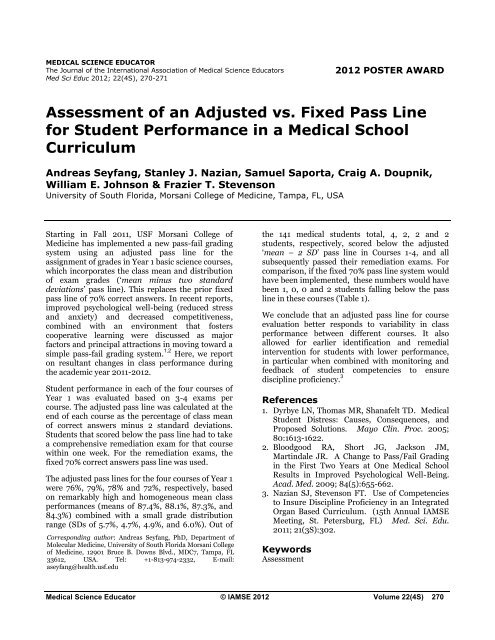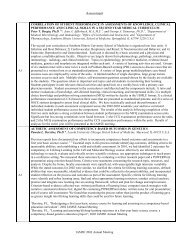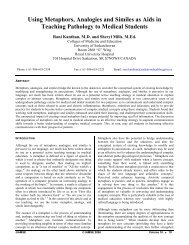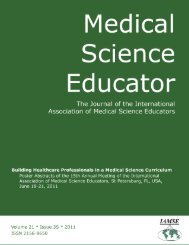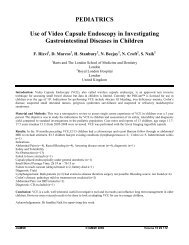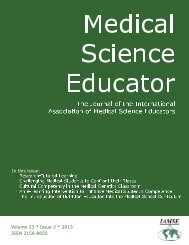Click here to view complete journal in pdf-format - IAMSE
Click here to view complete journal in pdf-format - IAMSE
Click here to view complete journal in pdf-format - IAMSE
Create successful ePaper yourself
Turn your PDF publications into a flip-book with our unique Google optimized e-Paper software.
MEDICAL SCIENCE EDUCATOR<br />
The Journal of the International Association of Medical Science Educa<strong>to</strong>rs<br />
Med Sci Educ 2012; 22(4S), 270-271<br />
2012 POSTER AWARD<br />
Assessment of an Adjusted vs. Fixed Pass L<strong>in</strong>e<br />
for Student Performance <strong>in</strong> a Medical School<br />
Curriculum<br />
Andreas Seyfang, Stanley J. Nazian, Samuel Saporta, Craig A. Doupnik,<br />
William E. Johnson & Frazier T. Stevenson<br />
University of South Florida, Morsani College of Medic<strong>in</strong>e, Tampa, FL, USA<br />
Start<strong>in</strong>g <strong>in</strong> Fall 2011, USF Morsani College of<br />
Medic<strong>in</strong>e has implemented a new pass-fail grad<strong>in</strong>g<br />
system us<strong>in</strong>g an adjusted pass l<strong>in</strong>e for the<br />
assignment of grades <strong>in</strong> Year 1 basic science courses,<br />
which <strong>in</strong>corporates the class mean and distribution<br />
of exam grades (‘mean m<strong>in</strong>us two standard<br />
deviations’ pass l<strong>in</strong>e). This replaces the prior fixed<br />
pass l<strong>in</strong>e of 70% correct answers. In recent reports,<br />
improved psychological well-be<strong>in</strong>g (reduced stress<br />
and anxiety) and decreased competitiveness,<br />
comb<strong>in</strong>ed with an environment that fosters<br />
cooperative learn<strong>in</strong>g were discussed as major<br />
fac<strong>to</strong>rs and pr<strong>in</strong>cipal attractions <strong>in</strong> mov<strong>in</strong>g <strong>to</strong>ward a<br />
simple pass-fail grad<strong>in</strong>g system. 1,2 Here, we report<br />
on resultant changes <strong>in</strong> class performance dur<strong>in</strong>g<br />
the academic year 2011-2012.<br />
Student performance <strong>in</strong> each of the four courses of<br />
Year 1 was evaluated based on 3-4 exams per<br />
course. The adjusted pass l<strong>in</strong>e was calculated at the<br />
end of each course as the percentage of class mean<br />
of correct answers m<strong>in</strong>us 2 standard deviations.<br />
Students that scored below the pass l<strong>in</strong>e had <strong>to</strong> take<br />
a comprehensive remediation exam for that course<br />
with<strong>in</strong> one week. For the remediation exams, the<br />
fixed 70% correct answers pass l<strong>in</strong>e was used.<br />
The adjusted pass l<strong>in</strong>es for the four courses of Year 1<br />
were 76%, 79%, 78% and 72%, respectively, based<br />
on remarkably high and homogeneous mean class<br />
performances (means of 87.4%, 88.1%, 87.3%, and<br />
84.3%) comb<strong>in</strong>ed with a small grade distribution<br />
range (SDs of 5.7%, 4.7%, 4.9%, and 6.0%). Out of<br />
Correspond<strong>in</strong>g author: Andreas Seyfang, PhD, Department of<br />
Molecular Medic<strong>in</strong>e, University of South Florida Morsani College<br />
of Medic<strong>in</strong>e, 12901 Bruce B. Downs Blvd., MDC7, Tampa, FL<br />
33612, USA. Tel: +1-813-974-2332, E-mail:<br />
aseyfang@health.usf.edu<br />
the 141 medical students <strong>to</strong>tal, 4, 2, 2 and 2<br />
students, respectively, scored below the adjusted<br />
‘mean – 2 SD’ pass l<strong>in</strong>e <strong>in</strong> Courses 1-4, and all<br />
subsequently passed their remediation exams. For<br />
comparison, if the fixed 70% pass l<strong>in</strong>e system would<br />
have been implemented, these numbers would have<br />
been 1, 0, 0 and 2 students fall<strong>in</strong>g below the pass<br />
l<strong>in</strong>e <strong>in</strong> these courses (Table 1).<br />
We conclude that an adjusted pass l<strong>in</strong>e for course<br />
evaluation better responds <strong>to</strong> variability <strong>in</strong> class<br />
performance between different courses. It also<br />
allowed for earlier identification and remedial<br />
<strong>in</strong>tervention for students with lower performance,<br />
<strong>in</strong> particular when comb<strong>in</strong>ed with moni<strong>to</strong>r<strong>in</strong>g and<br />
feedback of student competencies <strong>to</strong> ensure<br />
discipl<strong>in</strong>e proficiency. 3<br />
References<br />
1. Dyrbye LN, Thomas MR, Shanafelt TD. Medical<br />
Student Distress: Causes, Consequences, and<br />
Proposed Solutions. Mayo Cl<strong>in</strong>. Proc. 2005;<br />
80:1613-1622.<br />
2. Bloodgood RA, Short JG, Jackson JM,<br />
Mart<strong>in</strong>dale JR. A Change <strong>to</strong> Pass/Fail Grad<strong>in</strong>g<br />
<strong>in</strong> the First Two Years at One Medical School<br />
Results <strong>in</strong> Improved Psychological Well-Be<strong>in</strong>g.<br />
Acad. Med. 2009; 84(5):655-662.<br />
3. Nazian SJ, Stevenson FT. Use of Competencies<br />
<strong>to</strong> Insure Discipl<strong>in</strong>e Proficiency <strong>in</strong> an Integrated<br />
Organ Based Curriculum. (15th Annual <strong>IAMSE</strong><br />
Meet<strong>in</strong>g, St. Petersburg, FL) Med. Sci. Edu.<br />
2011; 21(3S):302.<br />
Keywords<br />
Assessment<br />
Medical Science Educa<strong>to</strong>r © <strong>IAMSE</strong> 2012 Volume 22(4S) 270


